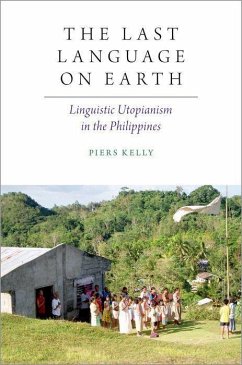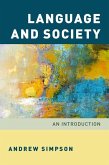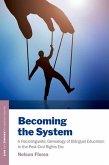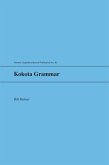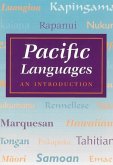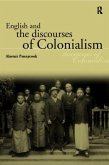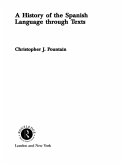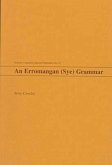- Broschiertes Buch
- Merkliste
- Auf die Merkliste
- Bewerten Bewerten
- Teilen
- Produkt teilen
- Produkterinnerung
- Produkterinnerung
The Last Language on Earth is the story of Eskayan, a constructed language from the Philippines. Unlike better-known invented languages such as Esperanto or Klingon, Eskayan has now been transmitted from generation to generation within its community for over a century and has come to be regarded by its speakers as the true indigenous language of the island of Bohol. The book considers the form of language itself as a point of departure, and analyzes the historical circumstances and ideological motivations that brought it into being and which continue to sustain it today.
Andere Kunden interessierten sich auch für
![Language and Society Language and Society]() Andrew SimpsonLanguage and Society84,99 €
Andrew SimpsonLanguage and Society84,99 €![Becoming the System Becoming the System]() Nelson FloresBecoming the System32,99 €
Nelson FloresBecoming the System32,99 €![Kokota Grammar Kokota Grammar]() Bill PalmerKokota Grammar37,99 €
Bill PalmerKokota Grammar37,99 €![Lynch Lynch]() John LynchLynch42,99 €
John LynchLynch42,99 €![English and the Discourses of Colonialism English and the Discourses of Colonialism]() Alastair PennycookEnglish and the Discourses of Colonialism66,99 €
Alastair PennycookEnglish and the Discourses of Colonialism66,99 €![A History of the Spanish Language through Texts A History of the Spanish Language through Texts]() Christopher PountainA History of the Spanish Language through Texts71,99 €
Christopher PountainA History of the Spanish Language through Texts71,99 €![An Erromangan (Sye) Grammar An Erromangan (Sye) Grammar]() Terry CrowleyAn Erromangan (Sye) Grammar41,99 €
Terry CrowleyAn Erromangan (Sye) Grammar41,99 €-
-
-
The Last Language on Earth is the story of Eskayan, a constructed language from the Philippines. Unlike better-known invented languages such as Esperanto or Klingon, Eskayan has now been transmitted from generation to generation within its community for over a century and has come to be regarded by its speakers as the true indigenous language of the island of Bohol. The book considers the form of language itself as a point of departure, and analyzes the historical circumstances and ideological motivations that brought it into being and which continue to sustain it today.
Hinweis: Dieser Artikel kann nur an eine deutsche Lieferadresse ausgeliefert werden.
Hinweis: Dieser Artikel kann nur an eine deutsche Lieferadresse ausgeliefert werden.
Produktdetails
- Produktdetails
- Verlag: Hurst & Co.
- Seitenzahl: 328
- Erscheinungstermin: 31. Dezember 2021
- Englisch
- Abmessung: 231mm x 157mm x 22mm
- Gewicht: 466g
- ISBN-13: 9780197509920
- ISBN-10: 0197509924
- Artikelnr.: 62536965
- Herstellerkennzeichnung
- Libri GmbH
- Europaallee 1
- 36244 Bad Hersfeld
- gpsr@libri.de
- Verlag: Hurst & Co.
- Seitenzahl: 328
- Erscheinungstermin: 31. Dezember 2021
- Englisch
- Abmessung: 231mm x 157mm x 22mm
- Gewicht: 466g
- ISBN-13: 9780197509920
- ISBN-10: 0197509924
- Artikelnr.: 62536965
- Herstellerkennzeichnung
- Libri GmbH
- Europaallee 1
- 36244 Bad Hersfeld
- gpsr@libri.de
Piers Kelly is a linguistic anthropologist whose research centers on the varied uses of writing and graphic codes in non-state societies, especially in West Africa, Southeast Asia, and Australia. He has previously worked as a linguist with the National Commission on Indigenous People, Philippines, and is currently affiliated with the Centre for Australian Studies at the University of Cologne, the Max Planck Institute for the Science of Human History in Leipzig, and the University of New England in Armidale, Australia. He is a co-editor of Skin, Kin and Clan: The Dynamics of Social Categories in Indigenous Australia (ANU Press, 2018).
Maps
Acknowledgments
A Note on Terminology
Prologue
Chapter One: Introduction
What this Book is About
What Pinay Understood About Language
A Language Forgotten, a Language Foretold
PART I: Locating the Eskaya
Chapter Two: Language, Literacy and Revolt in the Southern Philippines
Pre-contact Visayan Literacy
The 'Problem' of Language Diversity in the Colonial and Early
Commonwealth periods (1593-1937)
Shamanic Rebellion and Indigenous Outlaws in Bohol (1621-1829)
Enter the Eskaya (1902-1937)
Chapter Three: Contact and Controversy
First Contact
Media
Institutional Tribehood
A Formal Alliance and a Lost Report
Eskaya Responses and a New Research Agenda
PART II: Language, Letters, Literature
Chapter Four: How Eskayan is Used Today
Bohol in the Visayas
Language use in Bohol
A picture of the Fieldsite
The Spoken and Sung Somains of Eskayan
The Written Domains of Eskayan and Ideologies of Writing
Chapter Five: The Writing System
Writing Eskayan Sounds
Numbers
Script
The Past and Future of Eskayan writing
Chapter Six: Words and Their Origins
Eskayan Grammar
The Lexicon
Sources of Inspiration
Pinay's Lexical Agenda
Chapter Seven: Eskaya Literature and Traditional Historiography
The Origins and Scope of Eskaya literature
Language History in Eskaya Literature: A Summary and Analysis
Discussion
PART III: Insurrection and Resurrection
Chapter Eight: From Pinay to Mariano Datahan (and Back Again)
Datahan and the Origins of the Biabas Encampment
The Return of Militant Cults 1902-1922
Accommodation with the US Regime ca. 1914-1937
Datahan's Final War and Posthumous legacy
Chapter Nine: Eskayan Revealed: A Scenario
The Rise of English in Bohol as a Catalyst for Eskayan
How Pinay's Language was Revealed
Prophecy, Prolepsis and Time Depth
Summary
Chapter Ten: Conclusion: The First Language and the Last Word
Imagining Indigeneity from Above: The View from the Helicopter
The Form of Eskayan and the Identity of Pinay
Imagining Indigeneity from Below: The View from the Village
Regional Parallels
The (Re)invention of Linguistic Tradition
The Future of Eskayan
References
Glossary of Eskayan Terms Used in this Volume
Index
Acknowledgments
A Note on Terminology
Prologue
Chapter One: Introduction
What this Book is About
What Pinay Understood About Language
A Language Forgotten, a Language Foretold
PART I: Locating the Eskaya
Chapter Two: Language, Literacy and Revolt in the Southern Philippines
Pre-contact Visayan Literacy
The 'Problem' of Language Diversity in the Colonial and Early
Commonwealth periods (1593-1937)
Shamanic Rebellion and Indigenous Outlaws in Bohol (1621-1829)
Enter the Eskaya (1902-1937)
Chapter Three: Contact and Controversy
First Contact
Media
Institutional Tribehood
A Formal Alliance and a Lost Report
Eskaya Responses and a New Research Agenda
PART II: Language, Letters, Literature
Chapter Four: How Eskayan is Used Today
Bohol in the Visayas
Language use in Bohol
A picture of the Fieldsite
The Spoken and Sung Somains of Eskayan
The Written Domains of Eskayan and Ideologies of Writing
Chapter Five: The Writing System
Writing Eskayan Sounds
Numbers
Script
The Past and Future of Eskayan writing
Chapter Six: Words and Their Origins
Eskayan Grammar
The Lexicon
Sources of Inspiration
Pinay's Lexical Agenda
Chapter Seven: Eskaya Literature and Traditional Historiography
The Origins and Scope of Eskaya literature
Language History in Eskaya Literature: A Summary and Analysis
Discussion
PART III: Insurrection and Resurrection
Chapter Eight: From Pinay to Mariano Datahan (and Back Again)
Datahan and the Origins of the Biabas Encampment
The Return of Militant Cults 1902-1922
Accommodation with the US Regime ca. 1914-1937
Datahan's Final War and Posthumous legacy
Chapter Nine: Eskayan Revealed: A Scenario
The Rise of English in Bohol as a Catalyst for Eskayan
How Pinay's Language was Revealed
Prophecy, Prolepsis and Time Depth
Summary
Chapter Ten: Conclusion: The First Language and the Last Word
Imagining Indigeneity from Above: The View from the Helicopter
The Form of Eskayan and the Identity of Pinay
Imagining Indigeneity from Below: The View from the Village
Regional Parallels
The (Re)invention of Linguistic Tradition
The Future of Eskayan
References
Glossary of Eskayan Terms Used in this Volume
Index
Maps
Acknowledgments
A Note on Terminology
Prologue
Chapter One: Introduction
What this Book is About
What Pinay Understood About Language
A Language Forgotten, a Language Foretold
PART I: Locating the Eskaya
Chapter Two: Language, Literacy and Revolt in the Southern Philippines
Pre-contact Visayan Literacy
The 'Problem' of Language Diversity in the Colonial and Early
Commonwealth periods (1593-1937)
Shamanic Rebellion and Indigenous Outlaws in Bohol (1621-1829)
Enter the Eskaya (1902-1937)
Chapter Three: Contact and Controversy
First Contact
Media
Institutional Tribehood
A Formal Alliance and a Lost Report
Eskaya Responses and a New Research Agenda
PART II: Language, Letters, Literature
Chapter Four: How Eskayan is Used Today
Bohol in the Visayas
Language use in Bohol
A picture of the Fieldsite
The Spoken and Sung Somains of Eskayan
The Written Domains of Eskayan and Ideologies of Writing
Chapter Five: The Writing System
Writing Eskayan Sounds
Numbers
Script
The Past and Future of Eskayan writing
Chapter Six: Words and Their Origins
Eskayan Grammar
The Lexicon
Sources of Inspiration
Pinay's Lexical Agenda
Chapter Seven: Eskaya Literature and Traditional Historiography
The Origins and Scope of Eskaya literature
Language History in Eskaya Literature: A Summary and Analysis
Discussion
PART III: Insurrection and Resurrection
Chapter Eight: From Pinay to Mariano Datahan (and Back Again)
Datahan and the Origins of the Biabas Encampment
The Return of Militant Cults 1902-1922
Accommodation with the US Regime ca. 1914-1937
Datahan's Final War and Posthumous legacy
Chapter Nine: Eskayan Revealed: A Scenario
The Rise of English in Bohol as a Catalyst for Eskayan
How Pinay's Language was Revealed
Prophecy, Prolepsis and Time Depth
Summary
Chapter Ten: Conclusion: The First Language and the Last Word
Imagining Indigeneity from Above: The View from the Helicopter
The Form of Eskayan and the Identity of Pinay
Imagining Indigeneity from Below: The View from the Village
Regional Parallels
The (Re)invention of Linguistic Tradition
The Future of Eskayan
References
Glossary of Eskayan Terms Used in this Volume
Index
Acknowledgments
A Note on Terminology
Prologue
Chapter One: Introduction
What this Book is About
What Pinay Understood About Language
A Language Forgotten, a Language Foretold
PART I: Locating the Eskaya
Chapter Two: Language, Literacy and Revolt in the Southern Philippines
Pre-contact Visayan Literacy
The 'Problem' of Language Diversity in the Colonial and Early
Commonwealth periods (1593-1937)
Shamanic Rebellion and Indigenous Outlaws in Bohol (1621-1829)
Enter the Eskaya (1902-1937)
Chapter Three: Contact and Controversy
First Contact
Media
Institutional Tribehood
A Formal Alliance and a Lost Report
Eskaya Responses and a New Research Agenda
PART II: Language, Letters, Literature
Chapter Four: How Eskayan is Used Today
Bohol in the Visayas
Language use in Bohol
A picture of the Fieldsite
The Spoken and Sung Somains of Eskayan
The Written Domains of Eskayan and Ideologies of Writing
Chapter Five: The Writing System
Writing Eskayan Sounds
Numbers
Script
The Past and Future of Eskayan writing
Chapter Six: Words and Their Origins
Eskayan Grammar
The Lexicon
Sources of Inspiration
Pinay's Lexical Agenda
Chapter Seven: Eskaya Literature and Traditional Historiography
The Origins and Scope of Eskaya literature
Language History in Eskaya Literature: A Summary and Analysis
Discussion
PART III: Insurrection and Resurrection
Chapter Eight: From Pinay to Mariano Datahan (and Back Again)
Datahan and the Origins of the Biabas Encampment
The Return of Militant Cults 1902-1922
Accommodation with the US Regime ca. 1914-1937
Datahan's Final War and Posthumous legacy
Chapter Nine: Eskayan Revealed: A Scenario
The Rise of English in Bohol as a Catalyst for Eskayan
How Pinay's Language was Revealed
Prophecy, Prolepsis and Time Depth
Summary
Chapter Ten: Conclusion: The First Language and the Last Word
Imagining Indigeneity from Above: The View from the Helicopter
The Form of Eskayan and the Identity of Pinay
Imagining Indigeneity from Below: The View from the Village
Regional Parallels
The (Re)invention of Linguistic Tradition
The Future of Eskayan
References
Glossary of Eskayan Terms Used in this Volume
Index

